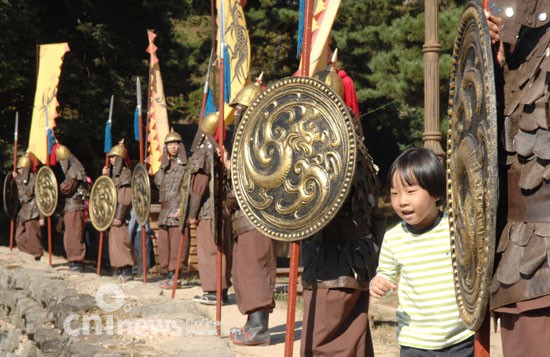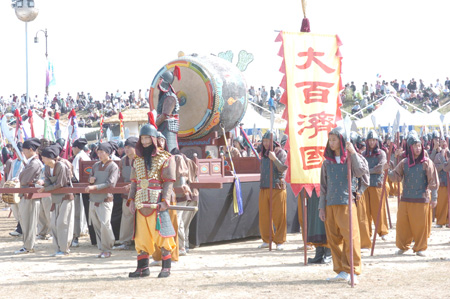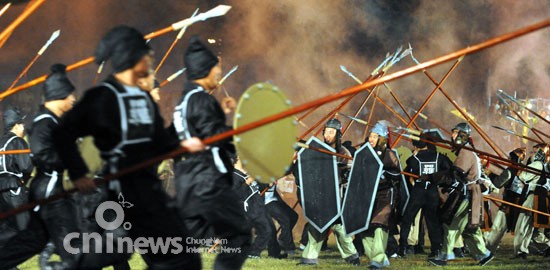About Chungnam
News
The Globalization of the Baekje Cultural Festival
1.53 Million Visitors Enjoyed ‘Ancient Culture’ for 10 Days
2009.08.26(수) | CNnews (![]() chungnamdo@korea.kr)
chungnamdo@korea.kr)
 |
||
Crowds to see the Festival Surged in Buyeo and Gongju
The total number of visitors to the recent Baekje Cultural Festival amounted to 1.53 millions including over 110,000 of foreigners. This number surpassing the origianlly expected numbers recorded the first among recent statistical records.
On October 3, the visitors over 178,000 overcrowded in the Guderai Dunchi, the broad terrace land of the Gumgang River, even though it was the first day of the festival. Especially, in the opening ceremony, over 50,000 of visitors surpassing the expected numbers filled the place to the right under the ceremony stage.
On the second day and the third day, crowd surged in Gongju, Buyeo and Nonsan recording 319,000 and 336,000 visitors each day. And during the festival, the crowdedness was so conspicuous as to make a several-kilometer tailback over the region.
So many foreigners visited the Festival and their coming proved that the Festival is growing up to a world-famous one. Delegates from 15 countries, the U.S. soldiers serving in Korea and their families viewed in group the opening ceremony and many Japanese rushed to the Festival by direct flight between Cheongju - Osaka on weekend. And about 160 foreign students studying in Korea enjoyed the Festival in group. According to a statistical report, foreigners enjoyed the Festival almost in ten to one among visitors on October 10, the previous day of the closing ceremony.
 |
||
Eye-catching Rehearsal of Hwangsanbul War and Traditional Cavalry Parade
The rehearsal of the Hwangsanbul Battle became the most popular program of the festival although it was introduced for the first time in the Festival. This rehearsal was highly estimated to have exactly revived the fierce battle between the suicide corps having only 1,500 soldiers of Baekje and its allied enemy forces. And the rehearsal is said to have given chances to exactly know about the battle situation through its magnificent and elaborate stage set, so realistic reenactment ofancient battle like a spectacular opera, and its compact scenario. The only disappointing fact is that the rehearsal was provided to visitors only twice during the Festival.
The traditional cavalry parade, which had gained great popu- larity in the 2007 Festival, also displayed its constant popularity during the Festival of this year. The number of horses participating in the cavalry parade greatly increased from 100 to 185 and this parade caught the eyes and received a big applause of viewers. Various performances and parades on the main stage before the opening ceremony were successfully performed and got a big applause from the audience. The parade of many interesting characters showing the power of Baekje as a foreign trade kingdom also caught sight of the audience and the pontoon bridge laid down in Gongju and Buyeo won great popularity as a strongly recommended place to visit among many families and couples.
Resurrected Kingdom with Power in Culture and Foreign Trades
The Baekje Village, which was constructed at the Sung-an Maul in the Gongju and at the Guderae broad terrace land by the Gumgang River, won so great popularity especially among children visitors. Children coming with their parents were absorbed in making crowns, masks and tiles of Baekje for themselves. The Festival provided diverse activities catching eyes of adults as well as children such as playing folk games, trying traditional dress and its ornament of Baekje, making a rubbed copies of traditional Baekje patterns etc. These popular activities made the Festival into a Festival by participants.
On the International Culture Exchange Village, which was made after the culture of the trading partners of Baekje, were provided the folkcraft articles and diverse traditional food of each country by the natives. And the folk art performed by natives of each country strengthened the meaning of ‘Cooperation and Participation’ between partners.
The traditional cavalry parade also presented a spectacular sight by the broad participation of the residents from Chungnam Province, Gyeongnam Province, Gyeongbuk Province, Jeonnam Province and Jeonbuk Province. And many parades hosted by cities and counties of Chungnam Province and events of making the traditional rice cakes and floating away oil light with wish contributed to make people positively participate in the Festival. The rehearsal of the Hwangsanbul Battle, the Gijisi Tug of War and the characteristics as a Multi-racial and Multi-cultural festival are evaluated as the factors of upgrading the Festival to extend and enrich the voluntary participation of the residents over all province.re..
 |
||
The Construction of the Largest Floating Bridge on the Baekma River
The largest floating bridge of the country appeared on the Baekma River in Buyeo County. Although the floating bridge originally constructed in 1921, it was removed in 1968 and reconstructed after 40 years for the Baekje Cultural Festival this year. This floating bridge is 250 meter long with 2.5 meter width and constructed to endure the load of more than 2,000 adults. More over, this bridge was made in a bascule bridge form to penetrate excursion ships and many Hwangpo-dotbae, Korean traditional sail boats.
Convenience for the Japanese Visitors to Come to the Baekje Cultural Festival
12:00 P.M., October 10, 2008, surged groups of smiling Japanese with each luggage into the welcoming hall of the Chungju International Airport which is located in 1 hour distance from Gongju and Buyeo by car.
One interviewee among them said, “Last night couldn't I well sleep fluttering with the expectation of seeing Baekje, my spiritual home.”
These are 132 Japanese visitors who entered Korea by the first flight after the opening the Cheongju-Osaka line to see the 54th Baekje Cultural Festival. Generally the visitors came from the Kansai Region such as Osaka City, Shiga Prefecture, Nara Prefecture etc. and are regional elite group like Professors, Doctors, Teachers and their families.
This direct flight line is said to cut short of the total flight time by 4 hours and the total cost by KRW 280,000 compared to those of the flight line to the Incheon National Airport.
A person concerned working in the Road Transportation Division of ChungNam Province said, “The reserved tourists are on the increase after the opening of the direct flight line between Cheongju and Osaka. There is a great possibility of gathering successfully a large scale of tourists every year by 2010 the Great Baekje Festival.”




